Tarak-tamga - the national symbol of the Crimean Tatars
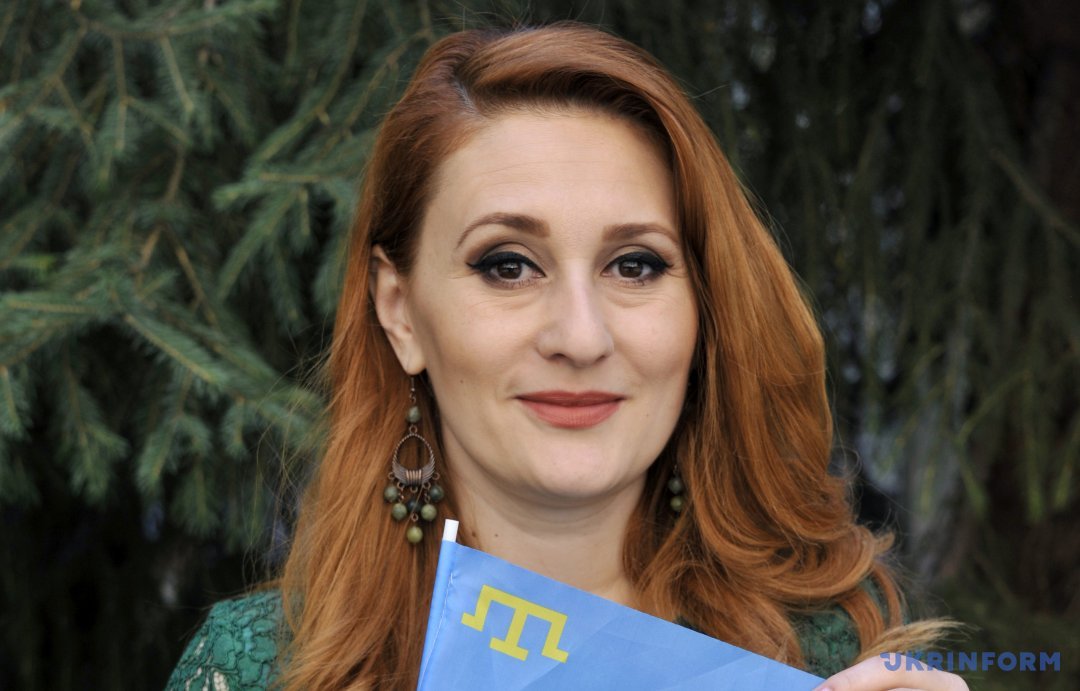
Analytics
26.06.2017 14:05
Ukrinform
The blue color of the flag means cleanliness, freedom and honesty
Today is the day of the Crimean Tatar flag. This is a relatively new holiday, which began to be celebrated in Crimea since 2010.

After the annexation of Crimea, he moved to mainland Ukraine and for the third year is celebrated both in Kiev and in other cities of the country. Ukrinform with historian Gulnara Abdulaeva offers to delve deeper into the history of the emergence of the blue panel with a golden tamga and find out the semantic accents of the still little-known symbol crimean Tatars.
1. Crimean Tatar flag - a blue cloth with a yellow tamga sign in the upper left corner of the flag.
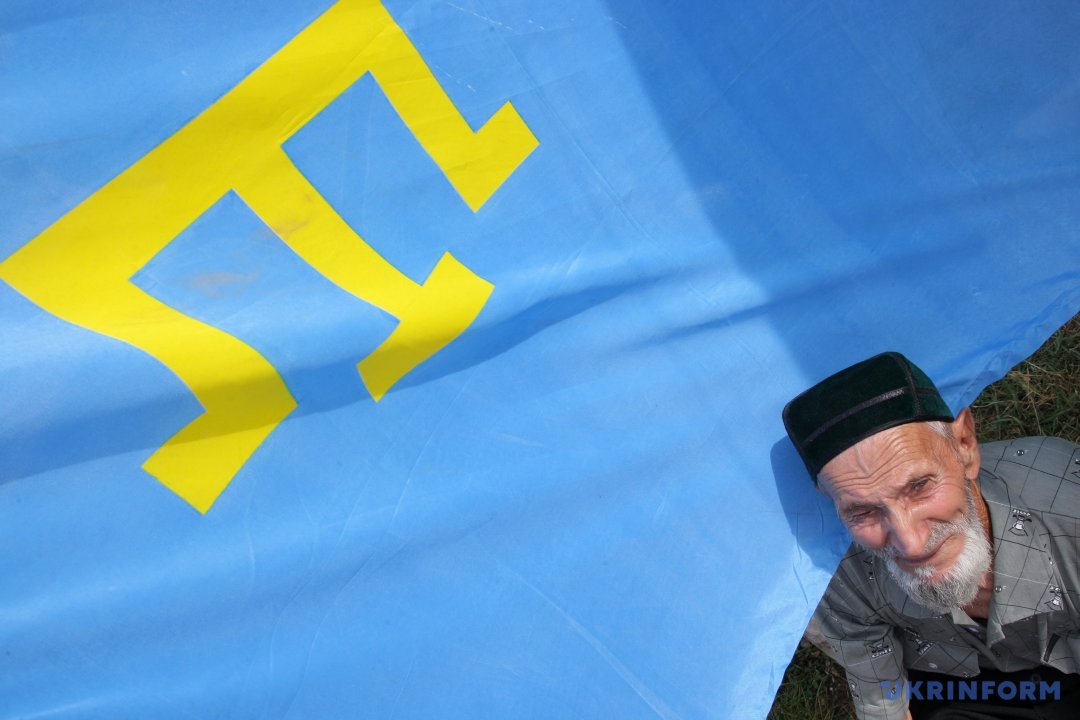
The Crimean Tatar flag is sky blue with a symbol of power - a tamga of golden color, located in the upper left corner of the shaft. The proportions of the flag, the ratio of width to its length - 1: 2 - have been strictly observed over the past two decades. They were approved at the second Kurultay of the Crimean Tatar people held on June 30, 1991 by the decision “On the national flag and national anthem of the Crimean Tatar people”.
2. Initially, the decision on the flag of the Crimean Tatars was taken at the first Kurultai, which was held in Bakhchisarai in 1917.
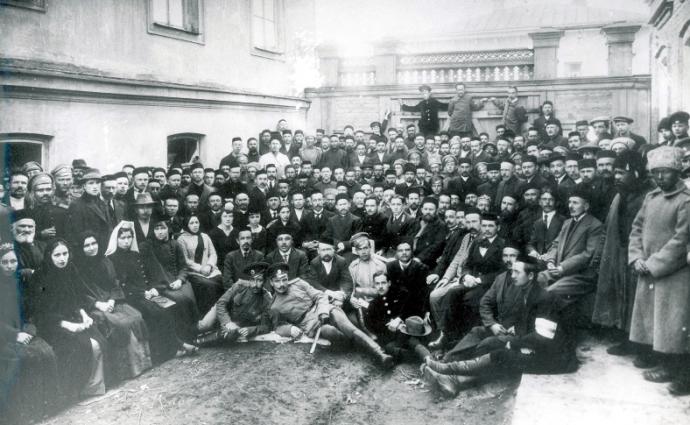
Since each noble family had their own symbols in the Crimean Khanate, the history of the Crimean Tatar state flag began in the first half of the 20th century. For the first time after the collapse of the Khanate in 1783, a flag with a tarak-tamga was approved as the state flag of the Crimean Tatars at the first Kurultai in November 1917. In 1920, during the occupation of Crimea by the Wrangel army, the flag of the Crimean Tatars was already becoming a national symbol.
3. The blue color of the flag means cleanliness, freedom and honesty.

The blue canvas and the golden tamga were not chosen by chance. The sky-blue color of the Turkic peoples is a synonym for purity and freedom, honesty and fidelity, impeccability and strength. From ancient times, it was associated with the endless sky, with steppe distances, clear rivers and lakes. The blue color was one of the symbols of the ancient Turkic beliefs - Tengrianism, faith in the one god Tengri. The very word "kok" (blue) in the Crimean Tatar language is the root of many other words related to concepts such as life, happiness and renewal. Monotony blue background associated with the desire for the unity of the people, peace and prosperity. It was these motifs that were reflected when choosing the primary color national flag Crimean Tatars.
4. Tamga is a symbol of power and is literally translated as signature, stamp, imprint, seal.
Scientists say that the word customs came from the word tamga.

If the blue cloth of the national flag was adopted only in 1917, then tarakh-tamga or, as it is also called, the trident has more ancient history. Tarakh (ridge) was a distinctive symbol of the power of the Crimean Khanate. The emblem was a T-shaped figure repeating one of the variants of the symbol of the genus Giraev, which is the founder of the state - the Crimean Khanate.
5. Tamga was in the Crimea for every noble family.

In the Middle Ages, a tribal sign - tamga was widespread among Turkic peoples. Each generation had its own tamga. As a rule, a descendant of a certain kind, borrowing the tamga of his ancestor, added some element to it or modified it. She was depicted on personal belongings and served as a symbol of property for persons belonging to a particular genus. She was labeled cattle, expensive utensils, family items, jewelry. The prototypes of tamgas were the simplest geometric figures. It could be a circle, square, triangle, as well as sacred pictograms, birds, animals, tools, weapons and horse harness, sometimes letters of different alphabets. Perhaps the prototypes of many signs were totemic animals or other symbols dating back to tribal relations.
6. The origin of tamga has several versions, one of which is that it is scales, as a sign of justice.

In the Crimean Khanate, the dynastic coat of arms of Giraev - tarakh-tamga - has several versions of its origin. According to the Turkic version, tamga was inherited by the Girai from the Genghisids. According to this version, trident means three genera that came from three brothers of divine origin. By the way, the triune symbols (three golden lilies in royal France, three golden lions in England since King Arthur) were inherent in many ruling dynasties. According to the second, Sarmatian version, the semantic meanings of the Crimean tamga are associated with the emblem of the Bosporus kingdom. Modern historians continue to argue about the meaning of the dynastic tamga Giraev. Someone claims that the Crimean Tatar trident represents scales, as a symbol of justice, some see it as an eagle. There are a number of other versions. It remains to add that historians still have discoveries about the meaning of the generic sign, which undoubtedly has deep roots and meanings.
7. Externally similar Ukrainian trident and Crimean Tatar tamga have different stories of origin.
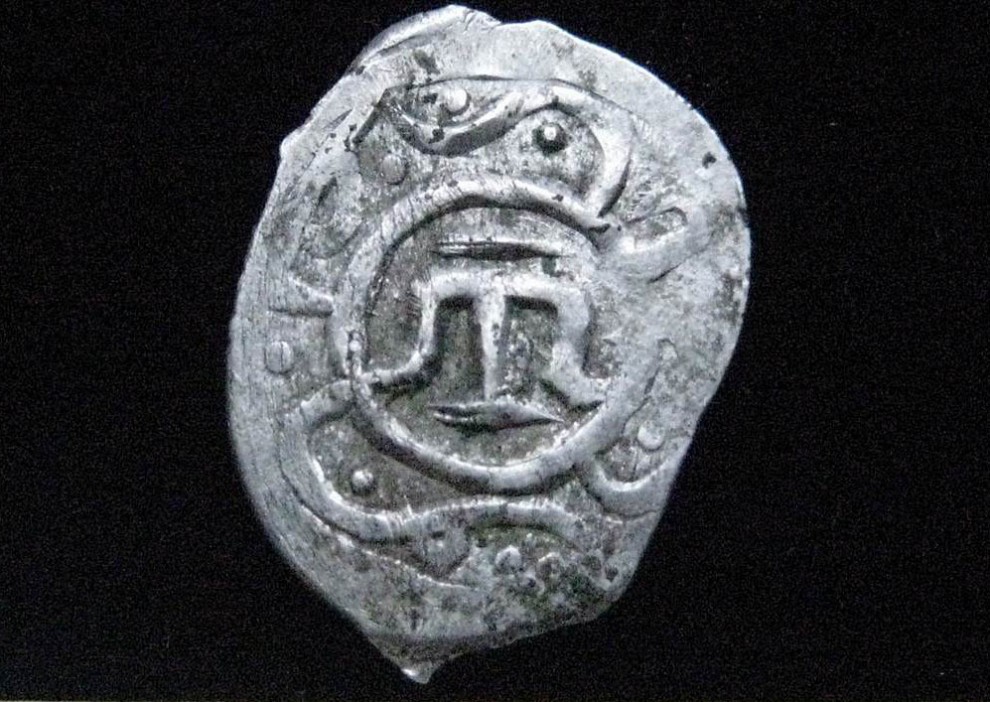
The Ukrainian trident also has a rich history, but its interpretation is in no way connected with the Crimean Tatar tamga. The meanings of these two symbols, according to historian Gulnara Abdulaeva, do not overlap, although some Ukrainian researchers argue the opposite.
8. In total, there were about 400 different types of tamgas in the Crimean state.

Turkologist in Crimea A.N. Samoilovich first described tamgas in 1917. Scientist Osman Akchokrakly collected about 400 tamgas in various places of Crimea in the summer of 1925. In 1927, a teacher of the Persian language V.I. Filonenko sketched 150 tamgas at three cemeteries in Kezlev (today - Yevpatoriya).
9. Tamga on money and documents recognized throughout the world.
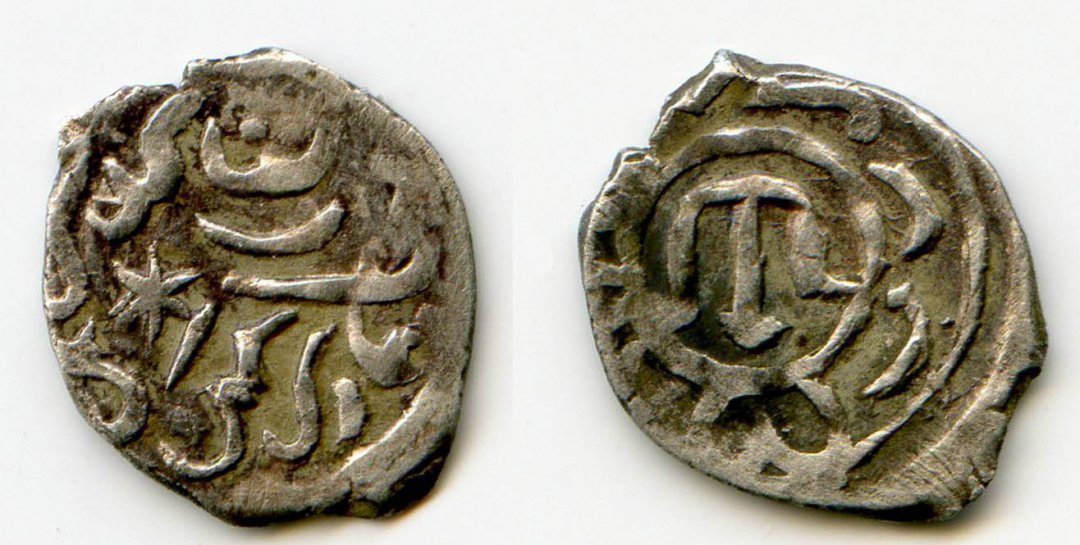
Tamga was depicted on all official documents-labels of the Crimean Khanate, on the city gates, buildings. Documents with the khan press were respected and recognized both in the Crimea and in Europe, Asia, the Near and Middle East and the Caucasus. The first Crimean khan Haji Girai began to print coins with the image of tamgas and was continued by his sons Nur-Devlet, Mengli Girai, Saadet Girai, Sahib Girai, Devlet Girai and others.
10. Day of the Crimean Tatar flag was established in 2010.
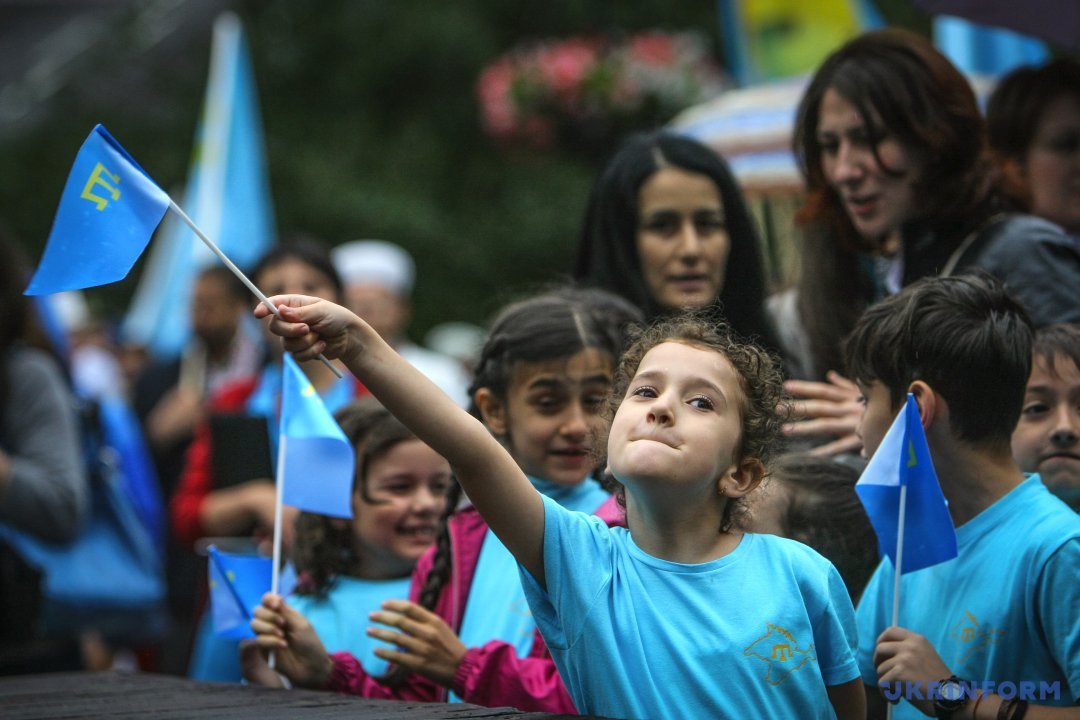
The initiative to celebrate the Day of the Crimean Tatar flag was made by youth organizations of the Crimea. The Mejlis of the Crimean Tatar people decided to establish such a holiday in 2010. Its goal is the unification of the people and the popularization of Crimean Tatar symbols.
Dictionary Ukrinform
Kok - blue
Kok Maw - sky blue
Sary- yellow
Bayrak - flag
Millet - people
Tamga - seal, sign, imprint
Khan - ruler
What is tamga? How is this word translated? What is the meaning of this symbol? Why do Crimean Tatars place tarak-tamgya in their banners?
These questions are answered by researcher Ablaeva Ulvie.
If you try to convey the meaning of a given word in “two words,” thenono simply means a sign of belonging. The synonyms are: generic or family sign, property symbol, emblem, label, stamp, brand, totem, seal, marker, pointer, etc.
Also, with the most superficial examination of the role of this proto-language in the history of mankind, it can be stated that it has acquired a comprehensive meaning (has still existed) in China and other Asian countries. In Western countries, the language of symbols was more the prerogative of the aristocracy, alchemists of secret societies. European heraldry grew out of similar property signs, moreover, in its turn, is the modern symbolism of the attributes of state power.
The word "tamga" of Smolgol literally means "stamp / seal"
The institution of tamga (ref. Institutio — custom, order, designation) arose in the nomad culture as a sign of tribal affiliation, when each tribal association adopted as its own symbol the most concise image of any animal, bird, weapon or instrument. With these signs, individual tribes of the Herods marked not only horses, cattle, but also many household items, designating the owner with several schematic lines. In the historical time, tamgas had names, symbolically designating objects of the nomadic world, for example, the Skatar Tatar “kylych” - a sword, “kamchi” - a whip, “chokuch” - a hammer idr.
In addition to purely applied significance, tamga was also a spiritual symbol of the genus. All the ancient tombstones of the steppe part of Crimea only patrimonial signs are engraved in the absence of the name of the deceased other text. These are the hieroglyphs of the Turkic-Tatars.
One of the oldest cult symbols of belonging is Tarak-tamga or "khan-tamga" of the dynasty of Crimean khans - Geraev. The word "tamga" of Mongolian literally means "stamp / seal". The mark is found in many cultures of various peoples of the world, from ancient Greece, where he symbolized the weapons of Zeus, the attribute of Poseidon and his image in the coat of arms of modern Ukraine. The spatial design of tamgas is also variable: its three arrows can look both upward from the base, and downward.
The semantics of the symbol are unknown to us, but the idea of \u200b\u200bthe Trinity is absolutely clearly stated in its graph. Perhaps the trinity of Time: "Past - Present - Future" under the auspices of the eternal Sky? Perhaps the trinity of human Nature: "Soul — Body — Mind"? Or heavenly scales, which weigh all the deeds of man?
Yes, the innermost meaning of tarak-tamga is lost, but, agreeing with well-known scientists that “... the language of symbols is a true, universal, universal language equally valid for all times of the nations” (V. Shmakov), we can say that tarak-tamga is true national symbol Crimean Tatars.
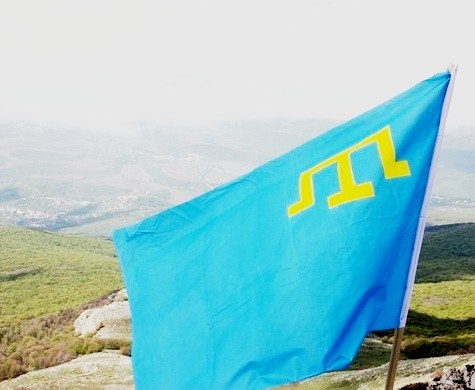
Crimean Tatars (Crimean Tat. Qırımtatarlar, kyrymtatarl, singular qırımtatar, kyrymtatar) - people, historically formed in Crimea. They speak the Crimean Tatar language, which belongs to the Turkic group of the Altai language family.
The vast majority of Crimean Tatars are Sunni Muslims.
The flag of the Crimean Tatars, which is a blue cloth with a yellow tamga emblem (Tarak-tamga - Crimean Tatar. Taraq tamğa) in the upper left corner. This symbol was used as a sign of the Giraev dynasty, the former rulers of the Crimean Tatars. Blue color is the traditional color of Turkic peoples, symbolizes clear sky and freedom. The flag was first adopted by the Kurultai (national congress) of the Crimean Tatars in 1917, after the February Revolution in Russia.
On June 30, 1991, this flag was re-accepted as a national one.

Tamga of the Giraev clan

The word "tamga" of Mongolian origin (the word "tamga" in Mongolian, "damga" in the Turkic languages) and had several meanings: "brand", "brand", "seal".
The prototype for tamga was the simplest geometric figures (circle, square, triangle, angle, etc.), sacred pictograms, birds and animals, household items, tools, weapons and horse harness. At the same time, the pictograms underwent a certain stylization, inevitable when drawing a mark on a selected surface with a heavy tool (chisel, knife, adze). The main requirements for a tamga-like sign are graphic expressiveness and laconicism, as well as the potential for variation within the existing pictorial scheme. So, probably, it was taken into account that the constant use of the sign by applying it to different surfaces (stone, leather, wood, etc.) will be the easier, the easier the mark will be drawn.
As tribal symbols, tamga passed into the heraldry of a number of ethnic groups.
Tamga examples
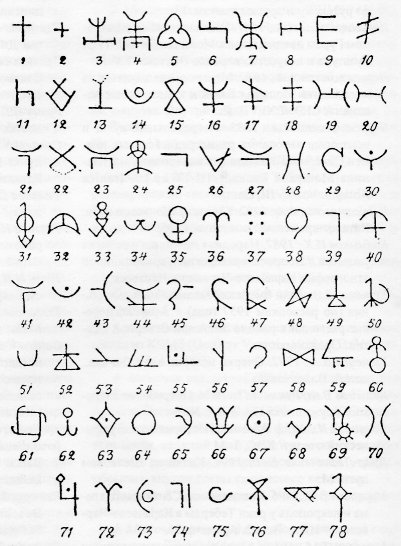
Tamga can be met on the arms of Ukrainian hetmans
Coat of arms of Bogdan Glinsky

Coat of arms of Christoph Nechkovsky

Coat of arms of Kalenik Andrievich

Drawings of Mir Teymur Mammadov, based on the Turkic patrimonial signs, moved me to write this post.
http: //www.site/users/usta777/blog/
Here is what the artist writes about tamgas: “Turkic tamgas are so diverse and beautiful in their graphics and stylistics that they quite naturally entered the cultures of many peoples. A huge number of both the tamgas themselves and their individual elements I constantly encounter in my travels through multinational Azerbaijan in decorative and applied art. Many tamgas have remained undisclosed, you can build versions, assumptions. Scientific analysis is possible in the case of the appearance of a number of analogues from different regions, which is very difficult. My collection has tamgas over 18,000 years old. They are copied from ancient ceramics. Some are easy to read, especially those related to the sun, earth, woman, masculinity. Others remained a mystery to me. I’m starting to publish drawings based on Turkic tamgas. ”


Tamga is a patrimonial sign of Turkic and some other peoples. As a rule, a descendant of a certain kind borrowed the tamga of his ancestor and added an additional element to it or modified it. The most common tamga among nomadic Turkic tribes. In particular, among Kazakhs, Kyrgyz, Tatars, Nogais, etc. The use of tamga has been known since ancient times, even among the Scythians, Huns, and Sarmatians. Tamghas are also known among many peoples of the northwestern Caucasus, Abkhazians.
Tamga marked horses, camels, and other cattle that were in the common ownership of the clan, or objects (weapons, ceramics, carpets, etc.) made by members of the clan. The image of tamgas can be found on coins. 
The word "tamga", of Turkic origin, had several meanings: "brand", "brand", "seal". During the Golden Horde, this term became widespread in the countries of Central Asia, Eastern Europe, the Near and Middle East, the Caucasus and Transcaucasia, where, in addition to the former, it acquired new meanings - “document with the Khan's stamp”, “(monetary) tax”. The Golden Horde khans issued labels with the seal - tamga. Tamga was called the internal tax (duty) in some countries of the East and Russia after the Mongol invasion in the 13th century. Fiscal in nature, it was levied on all goods sold, mainly in money. In Russia, until 1653, it was also levied on goods "unsold, only for their transportation." In this capacity, existed until the 70s. 16 century (abolished in Iran in 1565).
In Russia, the name "Tamga" was used in the 13-15 centuries. in relation to the collection of trade transactions. Local merchants in their city either did not pay tamga at all, or paid less than visitors. Since the middle of the 16th century, in connection with the gradual transfer of many trade duties to the calculation of the price of goods (that is, in a certain amount from the ruble), a new name for the levy appears - “ruble duty”.
The word customs also comes from the word tamga. The obvious popularity of this term in the Turkic languages, whence it was borrowed in other languages \u200b\u200b(including Russian), still cannot be considered evidence of the Turkic-Mongolian origin of tamg as a fundamentally new sign system, different, for example, from writing.
A man whose world was inhabited by many gods, who represented good and evil forces, depicted on the walls of caves, on household objects sacred animals, birds, natural phenomena. The prototypes of tamg were simple geometrical figures (circle, square, triangle, angle, etc.), sacred pictograms depicting birds and animals, household objects, tools, weapons and horse harness, sometimes letters of different alphabets.

Each clan chose a symbol for itself, endowed it with a sacred meaning, turning it into a totem. This image served as a generic sign, which distinguished this genus from others, testified that its carriers had a common origin.
Images of many (especially simple) signs could be used simultaneously or sequentially in several territorially, culturally and chronologically unconnected societies. At the same time, the pictograms underwent a certain stylization, inevitable when drawing a mark on a selected surface with a heavy tool (chisel, knife, adze, etc.). The main requirements for a tamga-like sign are graphic expressiveness and laconicism, as well as the potential for variation within the existing pictorial scheme. So, it was probably taken into account that the constant use of the sign by applying it to different surfaces (stone, leather, wood, etc.) will be the easier, the easier the mark will be drawn.
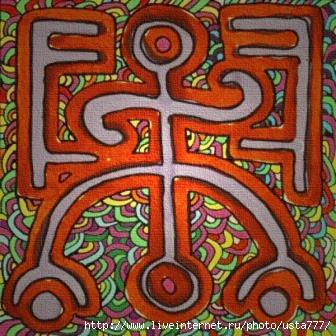
When the primitive clan was divided into communities and families, clan emblems turned into family ones, and later into personal ones. Tamga is not just a tribal sign with which livestock were labeled and boundary stones were labeled. This is, first of all, the signal “I am mine”. It initially contained not only a generic meaning, but also a geographical meaning. The carriers of one tamga are fellow countrymen, people of the same homeland.
The need for such labeling objectively exists in any society that is aware of the simplest opposition of “friend to foe”. As clan, professional, and other groups are distinguished and relations within this structure become more complex, the need for the existence of such iconic systems increases. With the advent of writing, the use of generic characters decreases. Further ways of developing tamga-like signs turn them either into coats of arms, or into sacred symbols, or into an element of ornament. However, sometimes tamga is still a generic sign of confirmation of ownership, ownership, etc.
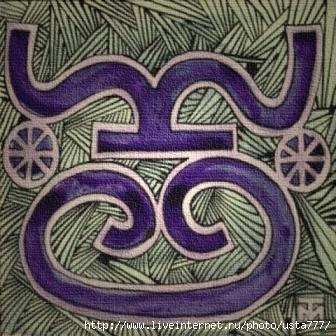
Here are some examples of tamga evolution.
The Ambassador of Castile at the Court of Timur in 1403, and the Arab historian Ibn Arabshah report a sign stamped on the seal of Timur - three equal circles located in the shape of an equilateral triangle.
It is not known for certain what meaning Timur made by choosing this sign for state pressbut the following explanation deserves attention: each circle means a part of the world, and the owner of the symbol is their Sovereign. Prior to the era of great geographical discoveries (XV century), it was believed that the world consists of Europe, Asia and Africa, washed by the Oceans. Having established dominance over these parts of the world, it can be considered the Lord of the World.
Five centuries later, the Heraldic Chamber of Russia will take into account the Tamerlane seal, and will include the sign in the coat of arms of Samarkand.

Coat of arms of Samarkand region
Russian Empire
Approved on January 31, 1890. Description of the coat of arms: "There is a silver, undulating pillar in the azure shield, followed by two golden branches of a mulberry tree on the sides. In the silver damask chapter of the shield there is the sign of Tamerlane's tamga (seal), i.e. three black rings I and 2. The shield is crowned by the ancient royal crown and is surrounded by golden oak leaves connected by the Alexander ribbon. "
The philosopher and artist N.K. Roerich discovers this sign in many cultures and traditions. "... The sign of triunity was spread all over the world ... Chintamani - the oldest idea of \u200b\u200bIndia about the happiness of the world - contains this sign. In the Temple of Heaven in China you will find the same image ... In the famous Memling’s picture on Christ’s chest is clear the same sign is visible. It is also on the image of the Strasbourg Madonna. The same sign on the shields of the crusaders and on the arms of the Templars. Gurda, the famous Caucasian blades, bear the same sign ... He is in the images of Gesser Khan and Rigden Japo. He is also on Tamge of Tamerlane, but he was also on the coat of arms of the Papal ... the same sign in the ancient image of St. Sergius. He is in the image of the Holy Trinity. He is on the coat of arms of Samarkand ... He is also on the Buddhist banners. Following into the depths of the Neolithic, we find the same sign in the pottery ornaments. That is why for the banner everything unites a sign was chosen that passed through many centuries - or rather, through millennia, while everywhere the sign was used not only in the form of ornamental decoration, but with special significance. If you put together all the prints of the same sign, then perhaps it will turn out to be the most widespread and oldest among the human symbols ... Where all human treasures should be protected, there should be such an image. ”
Summing up the results of his research, Roerich will call the Symbol the Banner of Peace and write: “This Symbol has great antiquity and is found throughout the World, therefore it cannot be limited by any sect, organization, religion or tradition, as well as personal or group interests, because represents the evolution of consciousness in all its phases. "
In 1929, the Symbol, in the form of three red circles (symbol of the past, present and future humanity) enclosed in a large circle (Eternity), will be approved, at the initiative of Roerich, as the Symbol of the Covenant of Culture (International Agreement for the Protection of Cultural Monuments during Wars and internecine clashes). Nowadays, this mark is officially patented by the Russian Agency for Patent and Trademarks and is used as official symbol protect the cultural heritage of mankind.
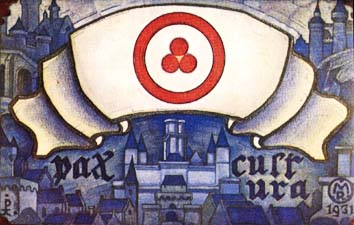
There are many examples of the use of tamg in heraldry.
The emblem of the Crimean Tatars - Tarak-tamga - is a patrimonial sign of the Giree dynasty that ruled in Crimea. The founder of the Crimean Khanate Haji I Giray was the first to use this symbol. Since then, this sign has been a symbol of the khan's power.

The Crimean Karaites chose a coat of arms in the form of a heraldic shield with images of the signs "Senek (wooden pitchfork)" and "Kalkan - shield", borrowed from a marble slab walled in unknown when and by whom over the gates of the eastern tower of the fortified city of Chufut-Kale.

State flag The Republic of Ingushetia, adopted on July 15, 1994, is: "A white rectangular panel, in the center of which there is a solar sign in the form of a red circle with three arched rays extending from it.

In the lower part of the state coat of arms of Ingushetia, the same solar sign is depicted, symbolizing the eternal movement of the Sun and the Earth, the interconnection and infinity of everything. The arcuate rays of the solar sign are rotated counterclockwise.

The tamga-like solar sign found on ancient stone sculptures is placed in the upper part of the coat of arms of the Republic of Khakassia.

From the color image attached to the text of the law, it follows that National emblem The Republic of Khakassia is a silver round shield, in the center of which is placed a red traditional Khakass women's breast ornament pogo in the form of a heart-shaped oval plate with a double narrow gold border. Pogo depicts in flight (in flight) a silver winged leopard with golden eyes and claws and a golden sketch of the outline of the figure and the characteristics of the musculature and skin of the leopard. Above the pogo in the upper part of the shield is a golden image of the Khakass solar sign with 4 “ears” and two silver concentric rings.
On the territory of Russia, images of tamgas turned into emblems. They began to be called "banners", "borders", "spots", "stigma", "stigma". With the development of private property, the mark-mark turned into a print. The press was also the main sign of the truth of state documents, treaties and messages.
The coat of arms of Ukraine was the patrimonial tamga of the Kiev princes.
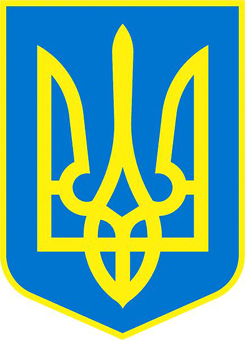
There are different theories about the origin and significance of the trident as a symbol of state power, the church or military emblem of Ukrainians, but none provides a satisfactory explanation. The most ancient archaeological finds of tridents on Ukrainian territory reach the 1st century. Believably, he was a sign of power, a symbol of the tribe, which later became an integral part of the Ukrainian people. From princely times, tridents on gold and silver coins of Prince Vladimir the Great, who apparently inherited this family-state sign from his ancestors, have been preserved.
Conventionally, these mysterious emblems were called "signs of the Rurikovich".

It was a kind of symbol of state power, a military emblem, a credential in international relations.
Further, the trident became a hereditary heraldic sign for the descendants of Vladimir the Great - Svyatopolk I (1015 - 1019), Yaroslav the Wise (1019 - 1054) and other princes. Two-tooth was beaten with the symbol of Izyaslav Yaroslavich (1054-1078), Svyatopolk II Izyaslavich (1093 - 1113), the Galician prince Leo And Daniilovich (1264 - 1301). In addition to coins, the trident sign was found on the brick of the Church of the Tithes in Kiev (986 - 996), on the tiles of the Assumption Church in Vladimir Volynsky (1160), on the brick and stones of other churches, castles, palaces, on dishes, weapons, rings, medallions, manuscripts . Signs resembling a trident and a grip were constantly found on various objects of Kievan Rus. They were met on tiles, on the most ancient Russian coins and seals, which fastened state documents, on the belts of combatants, their weapons and various ornaments. 
They tried to decrypt the symbol as a monogram. The mysterious sign, like a complex structure, was disassembled into its component parts. It consisted of Greek letters and was read as basileus. That is, the "king". It was the title of Byzantine emperors.
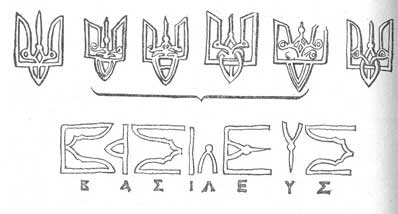
Distributed throughout all the principalities of the Kiev state for several centuries, the trident experienced changes right up to its transformation into a double-tooth, but retained its original Vladimirov structure. Among other changes in the classic Vladimir trident can be called the addition of a cross to one of the protrusions or to the side, a crescent moon, ornamental decorations and the like. To date, about 200 varieties of trident have been found. Although the trident individual dominant clans used as their family dynastic sign until the 15th century, but already from the 12th century it began to be replaced by a coat of arms with the holy archangel Michael.
For the first time, academician B. Rybakov seriously and scientifically considered these signs. Then it became clear that these signs are hallmarks of various masters, princely signs, tamga. For example, if an artisan belonged to a prince, then he placed a princely sign on his products. And everyone knew where the item was made or to whom it belonged. The princely signs on the plaques of the belts of combatants mean also the combatants of the princes.
Here is what the historian Pokhlebkin writes in his book “International Symbols” about the trident:
“Contrary to popular belief in recent years, the trident has never been an emblem of Kievan Rus (although its mention in the annals of 1096 as a tool of torment takes place). He was not the national emblem of Zaporozhye - the first prototype of the Ukrainian state of the 16th century, since this land was completely isolated from the sea by the territory of the Crimean Khanate. Therefore, attempts to trace the origin of the modern Ukrainian coat of arms and its main emblem from the supposedly "Kiev trident" are anti-historical, artificial and far-fetched. Like the modern flag of Ukraine (yellow-blackened ensign), the trident is not connected with the national symbols of the Ukrainian people and has no roots in the ancient Slavic historical tradition. Its borrowing can be explained both by church influence, and to a much greater extent by the Swedish-Ukrainian contacts of the Mazepov era (in Sweden there is not only the coat of arms of the society of Neptune, but also the flag of Neptune). As for the direct connection of this maritime emblem with the sea borders of Ukraine along the Black Sea, one should not forget that such a connection is extremely doubtful historically, since the Black Sea lands (the so-called Novorossiya) from the moment they joined Russia in 1783 and until 1917 administratively, they did not have any relation to the Ukrainian lands (Little Russia) and were included in Ukraine (Ukrainian SSR) only after the October Revolution.
Thus, the transformation of the trident into the coat of arms of Ukraine in 1992 does not have logically legitimate historical explanations. This is partly due to the heraldic incompetence of the nationalist figures of Rukh, and partly to the fact that the Ukrainian people, deprived of their statehood before 1917 and part of five states until 1939 (USSR, Romania, Hungary, Poland, Czechoslovakia), always lacked clear national emblems and symbols (if regional), since they have not taken shape in the entire history of this people from the sixteenth to the twentieth centuries. ”
So the study of this symbol continues. Who is right, time will tell.
The trident is very common in the symbolism of various cultures.
The TRIED, or the so-called "Neptune's Wand", is an attribute of the power of the god of the seas in the ancient mythology of Poseidon (Neptune) over the elements. The second attribute of Poseidon are two dolphins. The trident as a fishing tool is one of the varieties of the prison, which the island Greeks of the Aegean Sea beat dolphins and large sea fish entangled in nets. The trident, in fact, is a pitchfork with three prongs (ordinary pitchfork - with four). In Greco-Roman culture, the trident, symbolizes the thunderbolt, is the weapon of the heavenly god Zeus (Jupiter). In ancient Rome, the trident became at the beginning of a new era one of the traditional instruments of gladiators, and during the period of persecution of Christians - one of the instruments of torment of the rebellious. Hence, in the Byzantine church tradition, the trident became one of the emblems of martyrdom.
In European emblem, the image of the trident began to be used mainly only in the era of classicism (second half of the XVII - XVIII centuries) in connection with the general interest in ancient culture. The trident emblem received, in accordance with its historical use, the meaning of the symbol of power over the sea (water area) and began to be used in the arms of port cities, professional organizations of sailors, captain's clubs, unions of cavaliers of naval orders, etc.
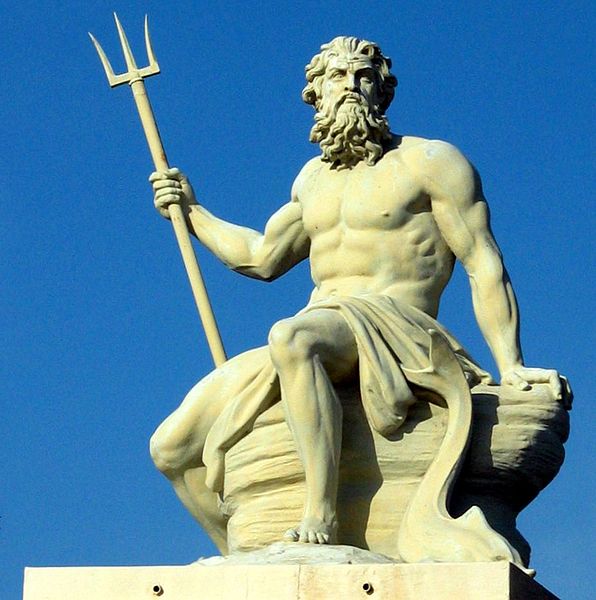

In the Christian emblem of the Orthodox (eastern) churches, the trident retained the meaning of the instrument of torment, the emblem of martyrdom. Three trident images have formed and exist mainly: Greek (straight), Roman (narrowed up) and Western European (middle prong above the other two)
In Christianity, the trident is sometimes used as a weapon of the devil. The trident in the hands of Satan plays the same role as the scythe in the hands of the allegorical figure of Death.
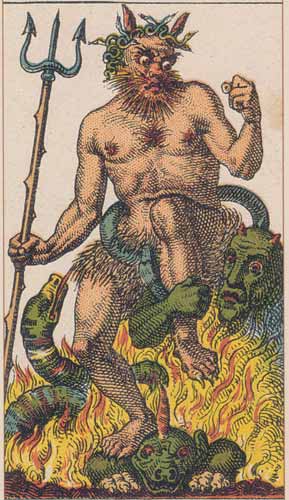
Milan Tarot
In India, a trishula similar to a trident is a weapon of the Hindu god Shiva and symbolizes three aspects of Shiva (creator, keeper, destroyer). The trident is depicted as a mark on the foreheads of his followers.
It is also a symbol of fire, reflecting the three entities of Agni.
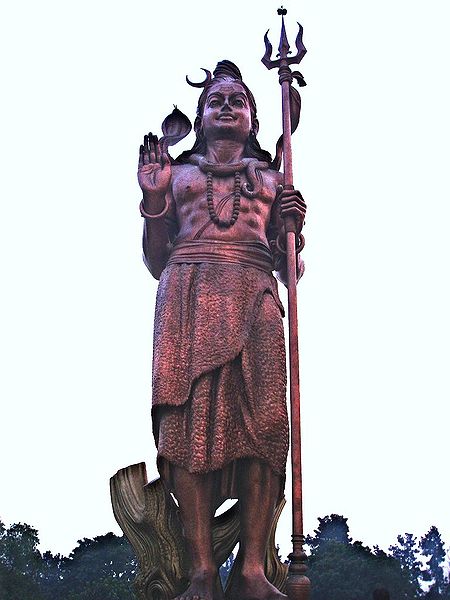
The image resembling a trident is also used in Buddhist symbols, but there it serves as the emblem of Buddhism or the monogram of the Buddha, or as a symbol of enlightenment, because it is not a weapon at all, but a stylized image of a trilingual flame and also the destruction of three poisons: anger, desire and laziness.
Returning to the theme of tamga used in heraldry, I cannot but quote excerpts from capital labor on the Russian heraldry of Alexander Lakier.
Alexander Borisovich Lakier (1826-1870) is a Russian historian.
Most famous was his Russian Heraldry (St. Petersburg, 1855). In this essay, which was of great importance until the beginning of the 20th century, Lakier makes an attempt to explain the Russian coats of arms. In Russian Heraldry, Lakier also gives the history of the seals of Russia - the only one up to the beginning of the 20th century.
First, a quote regarding the arms of the clans, "who left the lands of the Tatar, Cherkasy, from Armenia, Persia and Africa."
“Russia’s bicentennial stay under the Tatar-Mongol yoke, resulting from the frequent transitions of Asian servicemen to the Moscow court and especially the accession of Russia to Kazan, Astrakhan, Siberia and the Crimea, had the necessary consequence that both the royal families of Tatar origin, the princes and Murza, who made up their court, went to the service of the Moscow sovereign.
Having thus become in the ranks of the Russian nobility, "the kings of Turkey, and the large and nomadic hordes, Crimean, Kazan, Astrakhan, as well as the Nagai princes and Murzes" received the right to place their clans in our genealogies ...
There were no emblems of the Tatar clans before they were granted by the Russian sovereigns, but there were used special marks that distinguished one property from others (the brand is still burnt on horses, oxen), marks that were called yasaks or tamgas. They were worn on shields and also depicted on banners. Genghis Khan distributed three noble signs around his noble families: a bird, a tree, and the most honorable was the gyrfalcon; but upon the adoption by the Tatars of Mohammedanism, which prohibits the depiction of animals, these signs should have changed. ”
Considering the coats of arms of the noble families, "who left Lithuania and Poland," Lakier draws attention to the significant difference between the Polish and Lithuanian coats of arms from the West European.
“But, besides this heraldic school, there is another, with a completely different basic idea and therefore with a different outcome. This is a school polish. Its beginning dates back to the most ancient times of the existence of Poland, and since knighthood was little known in it, its inhabitants did not take part in the games and exploits that served in Western Europe as the application of heraldic ideas to life, the heraldry of this country acquired a completely different character . The simplicity preserved by the Polish emblems is still amazing. This is one sign, one sign, one banner, which, having become hereditary, took the form of a coat of arms. For the lack of historical information, it would be too bold to find their resemblance to tatar tamgas, yasaks and from this to conclude about the origin of the Polish clans from the Tatars. Comparing them with Russians bannerswhich we have already seen on the seals of private and officials, can lead to the opposite belief, i.e. that this character was not alien to the Slavic tribes in general, all the more so since these signs and symbols were directly borrowed from their agricultural life, from the nature that surrounded them and initially served only as insignia necessary in life for many cases. When the notion of Western emblems had already penetrated into Poland in later times, they were applied to the explanation of the Polish emblems: they began to be credited with a meaning that they did not initially have.
“How many root tribes were in ancient Poland, there were just as many distinctive signs and Kleinods for them. Every new family, like a private person who joined the Polish nobility, could not come up with their own sign or Kleinod, so it was taken under their protection by he attributed the native Polish family to his sign. Therefore, it was not enough to name the person, it was necessary to add: a nobleman of such and such a flag, coat of arms.
“In addition to the fact that a long stay under the rule of Poland of many Russian provinces, Lithuania and Ukraine led to the spread among the nobles of these areas the use of signs of Polish heraldry. In addition, their arms brought Polish and Lithuanian clans, many of whom came to Russia and Ukraine. These the emblems were taken up by local nobles in terms of similarity of names of characters, generic ties, and similarity of surnames. Therefore, one should not think that all aristocratic families belonging to Polish noblemen belong to arrivals from Poland. "
Here are some more quotes from Lakier’s work:
“When a country joined Poland, Polish heraldic emblems were also communicated to the inhabitants of the new province, and the native Polish clan introduced the emigrant to his coat of arms and attributed it to his banner. Therefore, in Poland several hundred names are often added to one emblem, which, adding to their name the name of the figure that is in their emblem, thereby give a complete concept of all of its emblem, which is essentially unchanged. This is no more than one figure, the outline is usually simple, and as soon as it allows some deviation from the once accepted norm, it gets a different name or forms a new (second, third) form of the former coat of arms. These qualities, i.e. the immutability of the heraldic figure and its belonging to many genera make up the fundamental difference between the Polish emblems and the Western European chivalry, which, as an expression of valor, cannot be completely identical between two brothers, but they certainly require some marks.
We do not even think that the emblems that we now see in the coats of arms could be given that name initially. They far from correspond to the concept, which is usually connected with the word coat of arms. The very simplicity, straightforwardness of the figure, its immutability for any random circumstances, the uncertainty of colors existing for some of them to date, give us every right to repeat here what we said above about the Russian arms.
These are nothing more than banners, like signs used to distinguish one family and a kind from other families of Herods, and if you look closely at our Polish and other Slavic emblems, you look for some root figures in them, a combination of which in this or that order and all the difference of arms is formed.
The cross, moon, stars, sword, arrows and horseshoes are the main figures for heraldic banners, which are found in many in our, Polish, Illyrian and Bohemian arms. Their meaning is understandable: the conquest of some Slavic tribes by alien peoples, their overthrow of this dominion, further, the transition from paganism to Christianity and, finally, their centuries-old struggle against the Tatars and other enemies could not but leave traces in the heraldry of Poland and other Slavic lands.
A noble knight who considered it humiliating for himself to fight on foot and, therefore, unimaginable without a horse, either imagined himself riding in armor (like, for example, in the Lithuanian pursuit), or instead placed a horseshoe in his coat of arms, the emblem most honored and beloved by the Slav . Not one thousand families in different Slavic lands use this banner as a representative of the horse knight. And in what forms and combinations the horseshoe does not seem! Further, the victory of the cross over the moon, i.e. paganism, Tatars, the victory won by the sword, and the reward that awaited in heaven everyone who fulfilled the orders of God (stars) on earth, make clear the meaning and significance of the above-mentioned heraldic figures. Most of the Polish emblems owe the same circumstance to the red, blood-soaked shield field. It seems to us that the figures encountered on them in their diverse combinations can be rightly called hieroglyphs of ideas, beliefs and traditions of various Slavic peoples: this quality makes up their fundamental, essential difference from the emblems of chivalrous Western Europe, from personal emblems, not folk. "
We find Polish symbols in the arms of the Ukrainian nobility.
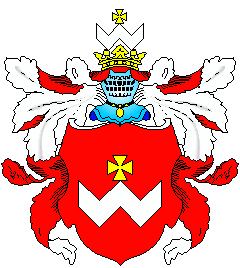
For example, the Khmelnitsky family used the ancient Polish coat of arms "Habdank". On the red box are two silver corners with cut ends, which are turned with their tops down and connected by the pattern of the letter W.
Mazepa’s ancestors received the privilege in 1544 to use the old “Russian” (Ukrainian) coat of arms “Kurch”, which belonged to the Volyn family of the Kurtsevichs, from where Mazepa’s ancestors also came. The emblem is based on a shield, in which a red field shows silver crossed forks in the middle, which are based on the same donkey (mantachuk) with ends bent up and are accompanied by a gold star on the right and the month on the left, with the horns of the month turned to the right. Above the shield was a knight's helmet with a noble crown and a kleinod in the form of three ostrich feathers.
![]()
From the data of recent studies, it is known that Kurch is an ancient emblem of the family of princes Kurtsevich, which developed, possibly, from the property mark of one of their ancestors. Perhaps the Mazeps were a branch of the Kurtsevich princes and used Kurch as a long-standing emblem of their ancestors;
Perhaps the Mazeps had family ties with the princes Kurtsevichs and were last adopted by their emblem; Perhaps the Mazeps were servants of the Kurtsevich princes and eventually began to use their coat of arms.

Upon receiving the nobility, the Orliks \u200b\u200breceived the privilege of using the ancient Korczak coat of arms: in a red field there are three silver beams that do not reach the edge of the shield, and each next (lower) beam is shorter than the previous one.
But why it is on the territory of Poland that the tamga so actively and universally accepts the functions of the coat of arms, I hope to reflect together. Waiting for your version.
Http://heraldry.hobby.ru/gub1/saobl.html
http://historic.ru/books/item/f00/s00/z0000042/st023.shtml
http://www.heraldrybooks.ru/book.php?id\u003d1
http://ru.wikipedia.org/wiki/%D0%9B%D0%B0%D0%BA%D0%B8%D0%B5%D1%80,_%D0%90%D0%BB%D0%B5 % D0% BA% D1% 81% D0% B0% D0% BD% D0% B4% D1% 80_% D0% 91% D0% BE% D1% 80% D0% B8% D1% 81% D0% BE% D0 % B2% D0% B8% D1% 87
http://uk.wikipedia.org/wiki/%D0%A2%D1%80%D0%B8%D0%B7%D1%83%D0%B1
"Http://en.wikipedia.org/wiki/%D0%94%D0%BE%D1%80%D0%B6%D0%B5"
http://www.elim.kz/forum/index.php?showtopic\u003d2765
http://forum.astrakhan.ru/index.php?showtopic\u003d29609
http: //www.site/users/usta777/blog/
(IMG: http: //kazan-tatar.narod.ru/pic/tamga.jpg)
http://www.apsny.ru/history/history.php?page\u003dcontent/tamgi.htm
http://ralf.com.ua/gerb/material_6.html
http://turan.info/forum/archive/index.php/t-4665.html
http://forum.tatar.info/index.php?showtopic\u003d2203
http://dic.academic.ru/dic.nsf/bse/171050/%D0%A2%D0%B0%D0%BC%D0%B3%D0%B0
http://gfx-group.info/faq.html?view\u003dmediawiki&article\u003d%D0%A2%D0%B0%D0%BC%D0%B3%D0%B0
http://www.bashedu.ru/encikl/t/tamga.htm
http://www.e-samarkand.narod.ru/Tamga.htm
http://dal.sci-lib.com/word039587.html
http://ru.wikipedia.org/wiki/%D0%A2%D0%B0%D0%BC%D0%B3%D0%B0
http://kraevedenie.net/2008/11/29/sarmatian-tamga/
http://www.myslenedrevo.com.ua/studies/znak/033/znak33-03.html
http://www.gumer.info/bibliotek_Buks/Culture/pohl/18.php
http://experts.in.ua/baza/analitic/index.php?ELEMENT_ID\u003d11012
http://history.org.ua/JournALL/Preprint/1990/4.pdf
- The training system according to the Dalton plan - the organization of the educational process - Sergei V. Sidorov
- Internal differences, specialization of individual cities
- Consonant and letter th
- Not a single word: whom to work after philology
- Warning flags on the beach
- Abstract of speech therapy classes in elementary school
- Sound and Alpha Word Analysis

 Live journal
Live journal Facebook
Facebook Twitter
Twitter